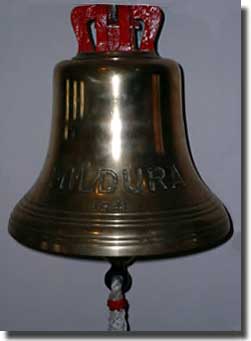|
Striking a Bell to Record Time, and Watches kept at Sea
The striking of a bell to designate the hours of being on watch at sea has its origin in the days of sailing ships. Then, the average sailor could not afford to own his own timepiece, and so relied on the ship's bell to tell the time.
Example of a ship's bell, here is a photograph of the bell from In those times, the ship's boy used a half hour sand glass to keep the time, when the sand had run out, his task was to turn the glass over to reset it, and ring the appropriate number of bells. One bell at the first half hour of a watch, and so on to the end of a four hour watch, when eight bells are struck and that watch it at its end. Watches kept in the Royal Australian Navy and the Royal Navy. These are timed as follows:
Dog Watches. The name most likely stems from DODGE WATCH, by making a total of seven watches in each 24 hour day, sailors would then not keep the same watch every day. A dog watch being only two hours long, whilst all other watches are of four hours duration. Thus a sailor will DODGE the same daily routine, DODGING the watch, or standing the DODGE watch, became corrupted to DOG, or DOGGING the watch ie standing the DOG watch. |

